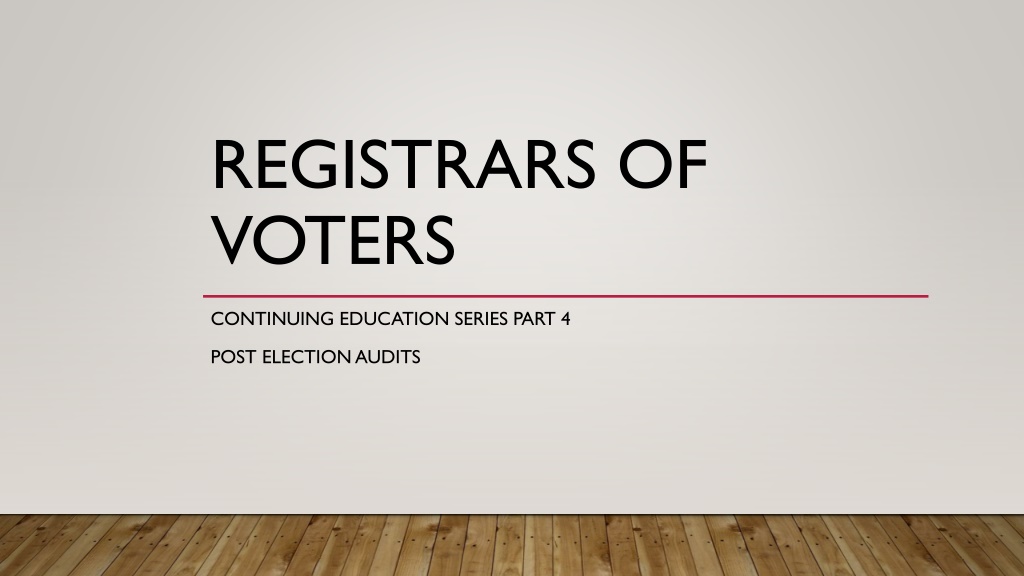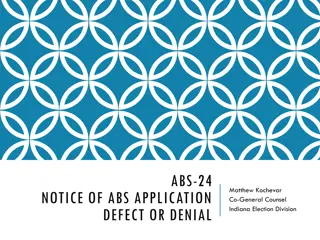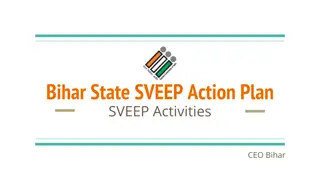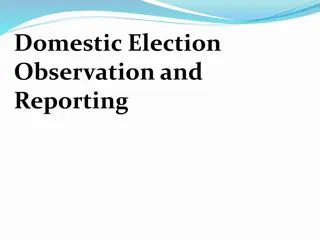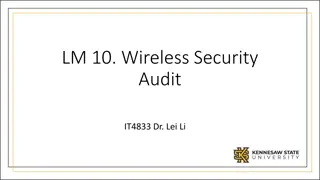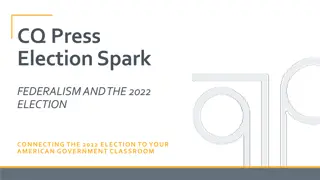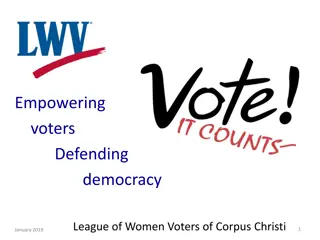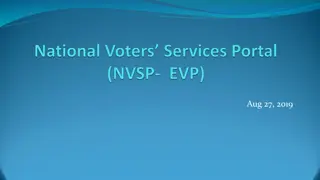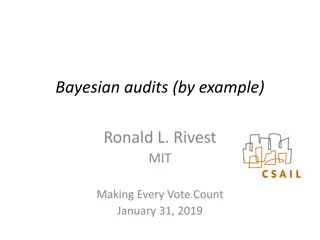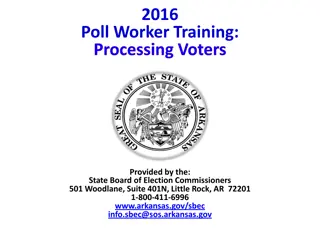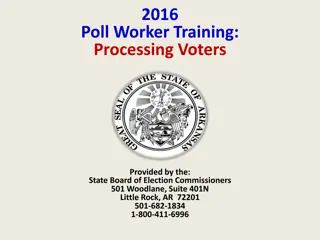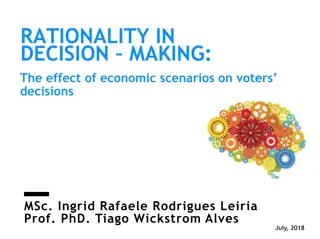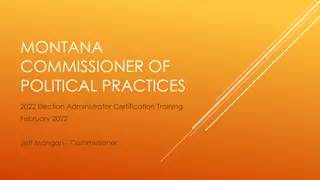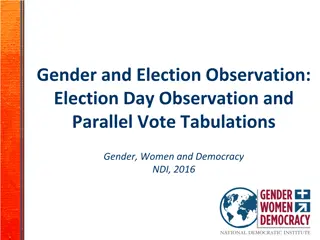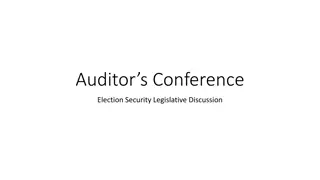Understanding Post-Election Audits for Registrars of Voters
Post-election audits are essential for ensuring the accuracy and functionality of optical scan voting machines. This process involves randomly selecting voting districts for hand count audits to assess machine performance. The chain of custody must be strictly maintained for ballots and equipment. Moreover, the selection of offices subject to audit is done in a transparent manner by municipal clerks in public ceremonies. It's crucial to separate ballots into distinct groups to evaluate machine accuracy effectively.
- Post-election audits
- Registrars of Voters
- Chain of Custody
- Optical Scan Voting Machines
- Election Integrity
Download Presentation

Please find below an Image/Link to download the presentation.
The content on the website is provided AS IS for your information and personal use only. It may not be sold, licensed, or shared on other websites without obtaining consent from the author. Download presentation by click this link. If you encounter any issues during the download, it is possible that the publisher has removed the file from their server.
E N D
Presentation Transcript
REGISTRARS OF VOTERS CONTINUING EDUCATION SERIES PART 4 POST ELECTION AUDITS
PURPOSE Pursuant to Public Act 07-194, mandatory post-election hand count audits are to be conducted by Registrars of Voters in five percent (5%) of the voting districts randomly selected to participate. These audits shall be open to public inspection. The primary purpose of the hand count audit is to assess how well the optical scan voting machines functioned in an actual election and to ensure that votes cast using these machines are counted properly and accurately. Please note: This is not a recount where the focus is reviewing each ballot to determine voter intent in rendering a final vote count. Rather, the audit tests whether the machines accurately counted ballots that were properly marked. Therefore, a critical part of the audit process is to separate ballots into groups: (1) ballots that are properly marked by voters (i.e., marked in such a way that one would expect the optical scan machine to be able to scan and read such ballots); and (2) ballots that one expects would not be read by the machine (e.g., a slash through the candidate oval, small dot or partially filled in oval).
CHAIN OF CUSTODY Whenever ballots are outside of secure storage they should at all times be under the supervision of at least two election officials of opposing parties (or candidates in a primary): This includes when they are stored and transported from the polling place after the election; When they are transported to the audit facility and room; and during and after the audit until they are returned to the secure storage. Ballots, memory cards, and tabulators must remain under seal and in secure storage from the time of pre-election testing until they are no longer needed for potential audits or audit investigations and they are released by the Secretary of the State. This includes districts not selected for audits, since the ballots and equipment may be needed for further investigations. Tabulators should remain under seal and in secure facilities, even between elections. The exceptions to these procedures are for use of ballots and the equipment for pre-election testing, election, and auditing requirements. Counting procedures should insure that all ballot counts, vote marks, and hash marks are read or verified by two eyes, that is, by two people of opposing parties (or candidates in primaries). When ballots are counted, they should be independently counted by two people or counted jointly one at a time. When ballots are stacked by candidate, two people must verify that all ballots in a stack are correctly classified. When votes are read, a second election official should verify that the call matches the mark being read. When hash marks are recorded either two officials should make and reconcile hash mark sheets or a second official must observe that hash marks are made for the correct candidate.
SELECTION OF OFFICES MUNICIPAL YEAR Once the municipalities and corresponding districts are identified by a lottery conducted by the Secretary of the State, the offices on the ballot that will be subject to the audit must be identified by the municipal clerk. In a municipal election, three offices or twenty per cent of the number of offices (not candidates) on the ballot, whichever is greater (three or twenty percent), shall be selected at random by the municipal clerk. Any selection must be done in a public ceremony open to the public.
SELECTION OF AUDIT TIME AND PLACE Each municipality may set its audit date individually. Audits may be conducted on or after the FIFTHEENTH day after the election or primary and must be completed by the date prescribed by the Secretary of the State. Please notify the Office of the Secretary of the State of the audit date and location(s) at least three business days in advance of the audit. The selected date must also be made publicly available. Any number of means may be used (posting notice in Town Hall and outside the Registrars office, posting notice on the municipality s website or newspaper advertisement).
SELECTION OF AUDIT PERSONNEL The Registrars of Voters have the responsibility for identifying appropriate workers to conduct the hand count audit. These individuals do not have to be the same individuals who worked at the polls on Election or Primary Day, but should be familiar with the procedures for counting paper ballots. Assistance for the audit may be solicited from municipalities not involved in an audit. If possible, poll workers from the Republican and Democratic Parties (in an election) or from opposing slates (in a primary) should be equally represented. If this is not possible, other appropriate poll workers may be used. The individuals selected are required to take an oath before performing their required duties.
DELIVERY OF THE AUDIT MATERIALS NOTE: Only those ballots that were counted by the optical scan voting machine in the district will be included in the audit. Absentee and EDR ballots counted centrally or by hand are now included in the audit if the town s central ballot location is selected in the audit drawing. On the day of the audit, all ballot materials must be delivered to the audit location by two individuals of separate political parties or opposing slates (in a primary), if possible. Optical scanners are not part of the audit and should not be brought to the audit location. All audit procedures shall be open to public inspection and administered by the Registrars of Voters. Ballots should remain sealed and secure and no activities related to the audit should begin until the announced time of the audit.
CONDUCTING THE AUDIT Step 1: Confirm Security of the Ballots When the audit begins, audit workers shall first examine the seal or protective tape on each of the ballot depository containers. This seal number should be checked by two individuals, written down on the attached forms, announced publicly, and then compared to the number recorded on the moderator s report. If any of the seals referred to above have been broken, or are different from those applied on Election or Primary night, the Registrars shall immediately notify the Elections Division of Office of the Secretary of the State.
CONDUCTING THE AUDIT Step 2: Determine which ballots are to be included in the Audit Once the balloting materials have been removed from their respective containers, all ballots shall be reviewed and sorted by two individuals from opposite political parties or opposing slates (in a primary), if possible, to determine which ballots will be part of the audit. NOTE: Only those ballots that were counted by the optical scan voting machine in the district will be included in the audit. That includes: all ballots taken from the machine-read main section of the ballot bin; and all write-in ballots taken from the machine-read, write-in section of the ballot bin. Any ballots counted by hand on Election or Primary Day are not included in the audit. Absentee and EDR ballots counted centrally are now included in the audit only if the town s central counting location is selected during the audit drawing. Absentee and EDR ballots counted at the polls and counted by the tabulator should be included in the audit.
CONDUCTING THE AUDIT Step 3: Count Total Number of Ballots The total number of paper ballots read by each optical scan Count Total Number of Ballots: machine should be recorded and used as a check to assure that all ballots counted by the machine are included in the audit. This number can be determined by a separate count of the number of ballots before counting the votes, perhaps while carefully separating the ballots into batches to be counted by teams. This number should be the same as the number printed on the tabulator tape at the close of the polls.
CONDUCTING THE AUDIT Step 4: Sorting the Ballots Each ballot shall be examined by two individuals from opposite political parties (in an election) or slates (in a primary). In case of a disagreement, the Registrars of Voters shall make the final decision on categorizing ballots. The ballots should be assigned to one of the following two categories: Undisputed Ballots - The first category of ballots includes those ballots that both individuals agree should have been read by the optical scan voting machine. In other words, a review of the ballot in question reveals that each oval is completely filled in, there are no apparent problems, voter errors, unusual markings or noticeable stray marks in or around any of the races to be audited. This shall include any write-in ballots and over-voted ballots. Ballots with Questionable Votes Ballots that contain problems, voter errors (e.g., check marks in the candidate s oval), stray or unusual markings in any of the races being audited should be placed in this category because such problems, errors or markings may have interfered with the optical scan machine s count. Here, audit workers agree that the ballots may not have been read by the optical scan voting machine. Note: When counting an individual contest, votes should be counted as questionable only if the particular contest being counted has votes that are questionable on the ballot. These questionable votes include those ballots where bubbles are partially filled in, even with a small dot.
CONDUCTING THE AUDIT Step 5: Counting the Ballots Count the Total for Each Candidate: Once the ballots are separated, the audit workers shall count the votes for each candidate in each of the audited races on each ballot first, from the Undisputed Ballots, i.e., ballots with no questionable markings; next, from the Ballots with Questionable Votes, i.e., where questionable markings appear for the particular race and candidate. The audit workers will keep separate vote totals for each candidate from both categories of ballots. In addition, audit workers should not be aware of the machine totals from election night as they are counting the ballots and vote totals during the audit process. Note: In order to minimize tallying errors, it is recommended that audit workers sub-divide ballots into batches for ease of counting and for detecting human tallying errors. Batch size may vary, but experience shows that batches of no more than 50 ballots are easiest to manage and track. It may also be useful to assign two workers, from different parties if possible, to tally--make "hash marks" for -- each batch and to reconcile their subtotals after completing each batch of ballots. Each batch of ballots should be numbered and separate tally sheets prepared for each batch. The batches and their respective tally sheets should remain separate in order to make reconciliation, if necessary, easier for audit workers. Note: Never write on the ballots. However, sheets or stick notes can be clipped or stuck to each pile to identify the ballot and vote counts. If a notation needs to be made on an individual ballot, then that ballot should have a paper clipped or a sticky note attached. Note: Counting Cross-Endorsed Candidates: The law and tabulators count votes for cross-endorsed candidates in a precise and special way. Your counting must conform to that method. You will note that cross-endorsed candidates usually have three lines on machine tapes, (e.g. Jackson-Dem, Jackson-Wkf, Jackson-Unk). The Unk count means Unknown and corresponds to situations where a voter filled in bubbles for the candidate more than once. As such, when counting votes for cross-endorsed candidates it is very effective to create a category/count for Unknown and tally votes there for instances where more than one bubble is filled in for the same candidate.
REPORTING BALLOT TOTALS The results of this manual audit shall be recorded on the attached form. Do not leave any space empty. Incomplete forms will not be accepted. For each candidate in each office being audited, the total hand count of Undisputed Vote Totals should be recorded in Column D and the total hand count of Questionable Vote Totals should be recorded in Column E. Each Questionable Vote should be explained in the comments section of the audit report. Use additional space as necessary. For example: 5 instances of substantially incomplete bubbles .
HANDLING DISCREPANCIES If Column C (the machine total) is greater than Column F (the overall hand count total), or less than Column D (the undisputed hand count total), then every effort should be made to investigate and explain why such is the case, including conducting a second hand count, if necessary. Any difference should be reported to the Secretary of the State. Small differences of one or two unexplained votes can often occur, but such differences should be verified by at least two counts. It is your responsibility to be thorough and comfortable that your counts of the ballots are accurate. If you are not confident in your counts then you should continue counting and recounting until you are satisfied that your hand count result is accurate. If the results of the audit reveal any unexplained deviations or errors, The University of Connecticut (UConn VoTeR Center), at the request of the Registrars of Voters or Secretary of the State, shall examine the machines that apparently produced incorrect results to determine if such errors were caused by the optical scan voting machine.
CLOSING THE AUDIT At the completion of the audit, all ballot materials shall be resealed and returned to a secure location and the optical scanners shall remain sealed until such time as the Secretary of the State notifies each municipality that the voting machine seals can be removed and the memory cards can be reprogrammed for any future election.
CONTINUATION OF THE AUDIT AT ANOTHER TIME If the audit is to be continued in another session, the following steps should be taken to ensure the security of the ballot: (1) The ballots should be resealed in the bag and opened again at the start of the subsequent session; (2) New seal numbers must be recorded at the end of one session and the start of the next; (3) Observers present and the Secretary of the State s office should be notified at the end of the session of the date, time and location of the continuation of the audit; and (4) All audit materials should be delivered by the Registrars of Voters to a secure location during the interim period between audit sessions.
ROLE OF OBSERVERS The State of Connecticut is committed to an open, public, and transparent process. Public Act 07-194 specifically provides that the audit shall be open to public inspection. This means that observers should be allowed to view every aspect of the proceedings, including being close enough: (1) to actually see ballots as they are being counted; (2) to see tally sheets as they are being marked and when they are complete; (3) to see report forms to be sent to the Office of the Secretary of the State; (4) to be able to verify that the counts from tally sheets are properly added and conform to the totals on the report forms; (5) to be able to verify the seal number(s) and observe the condition of the seals before they are broken; (6) to observe the moderator s report, machine tape, and other documents created on election day; and (7) to view any other documents created in the process and to ask questions of Registrars regarding the process. Observers should be allowed freedom of movement sufficient to enable them to view the items described above. However, it lies within the discretion of the Registrars of Voters to ensure that no observer disrupts the integrity or the orderliness of the process.
THE END Thank You!
